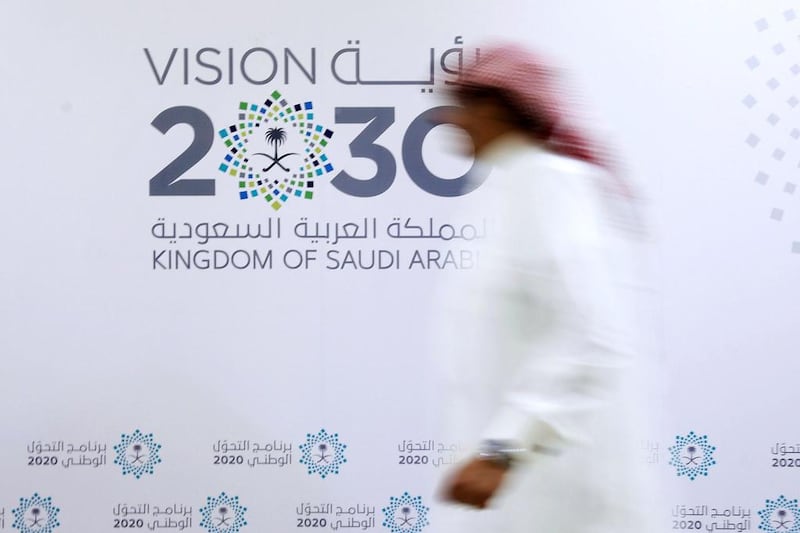Saudi Arabian officials have started to flesh out the country’s National Transformation Plan, adding some more ambitious targets after the cabinet approved the blueprint late on Monday.
Among the main targets added to those announced earlier in the year was the creation of more than 450,000 new private sector jobs by 2020 and a more than tripling of the government’s non-oil revenues, from about 163 billion Saudi riyals (Dh159.63bn) the year before last to 530bn riyals by 2020.
Other targets include, a reduction in the government’s wage bill by 26bn riyals, to 458bn riyals, so that wages’ share of the budget drops from 45 per cent to 40 per cent. It also targets savings on water and electricity subsidies of 200bn riyals by 2020, having last year announced the first move towards market-rate utility bills.
Much of the document released yesterday was devoted to explaining the bureaucracy involved in delivering and monitoring the progress of the plan and it bears all the hallmarks of the many consultancy groups that have advised Prince Mohammed bin Salman, the deputy crown prince, particularly McKinsey and Company’s Saudi Arabia Beyond Oil report in December, led by Gassan Al Kibsi, the head of its Riyadh office, which is widely thought to be the blueprint for the blueprint.
The national plan sets out very specific goals and “key performance indicators” for 24 government departments, which include a wide range of social goals, such as reducing the waiting list for housing and speeding up the judicial system.
But the targets that will be of most interest to international observers will be the financial goals, and particularly the efforts aimed at transforming the labour force and rebalancing the economy so that it moves away from a heavy reliance on the public sector.
McKinsey’s report laid out a scheme whereby about US$4 trillion of investment would be made, mainly in the private sector, which could double the country’s GDP and create 6 million jobs by 2030.
The growth and job creation is much needed because of the country’s growing working age population, the labour participation rate, which at 41 per cent, remains low, and an over-reliance by the indigenous Saudi population on the government, which accounted for about two-thirds of jobs in 2014. With population growth and rising labour participation, the Riyadh investment company Jadwa forecasts that 226,000 Saudis per year will be eligible to enter the workforce over the next decade.
To address this, the Saudi national plan finance committee has approved 543 initiatives, with a total cost for the government over the next five years of about 270bn riyals.
McKinsey identified eight industries that would be key to the transformation, including health care. The Saudi plans call for the private sector share of healthcare provision to rise from 25 per cent currently to 35 per cent by 2020, with a doubling across the board of Saudis in training as doctors, nurses and other healthcare professionals.
There are similar goals to increase employment levels in information and communication technology, tourism and in non-oil mining and manufacturing in industries such as military equipment. The plan calls for a ninefold increase in the number of Saudis enrolled in technical or vocational training – to more than 900,000 – to be able to meet the skill levels that will be required in these fields.
But while the transformational ambitions have met with widespread approval, there has also been scepticism that Saudi Arabia will be able to achieve so much in so short a time given the huge demographic, political and cultural challenges.
“They’ve talked about creating jobs in the military and marine industries, but these are sectors where a great deal of vocational training is needed and that is just not yet available in the country,” said Courtney Freer, a researcher at London School of Economics’ Middle East Centre.
Still, Saudi Arabia has managed to make significant reforms, both at the end of the 1990s, when it faced another fiscal crisis because of a collapse in oil prices, and more recently, said David Butter, a research fellow and Saudi expert at Chatham House.
“Their capacity to change fast shouldn’t be underestimated,” said Mr Butter. “At the end of the 1990s they were in a much worse position than now and managed to get public debt under control, start developing the capital markets and get the ball rolling on privatisation.
“Look at private sector employment over the last five years – in some ways it’s been revolutionary, particularly on the numbers of women employed,” which has grown about tenfold since 2010.
The key factors to keep an eye on over the next couple of years will be whether the Saudi targets to reduce the public sector’s share of employment are on track, as well as increasing foreign direct investment (FDI), said Ms Freer. “I think they’ll make progress but I think the targets are unrealistic,” she said.
A determining factor will also be whether the momentum Prince Mohammed has been able to generate because of the oil price crash will be lost if oil prices continue their recovery through next year, and the domestic political momentum with it.
“I think there are a lot of areas of friction,” said Mr Butter. “Friction from the young elite, the guys with MBAs and American-style business boardroom ideas of how things should be versus young Saudis who lag and are still coming on to the labour market lacking skills. If oil prices go up I do think [momentum] would slow down.”
Read the full National Transformation Program here.
amcauley@thenational.ae
Follow The National's Business section on Twitter





